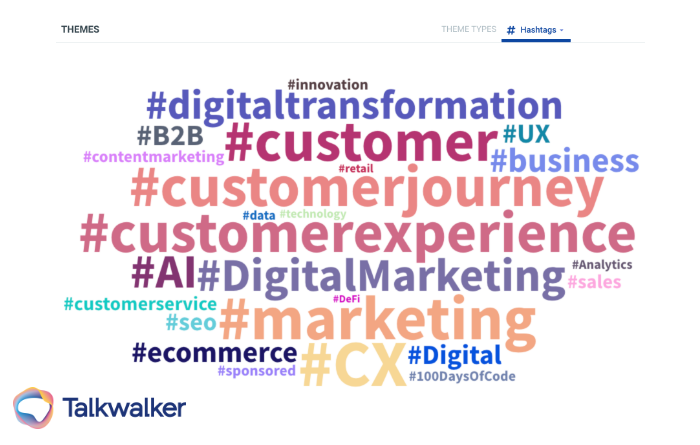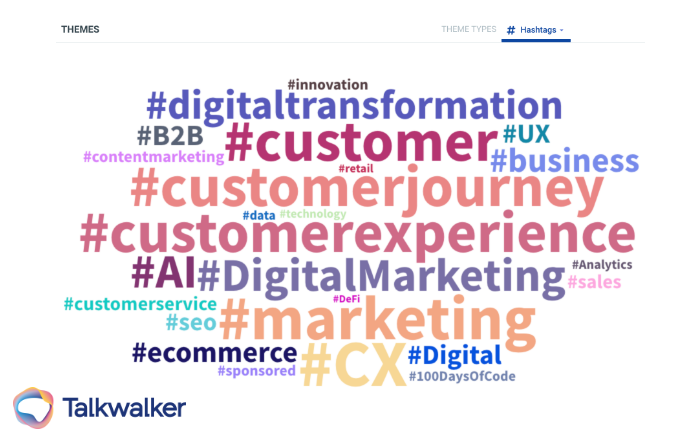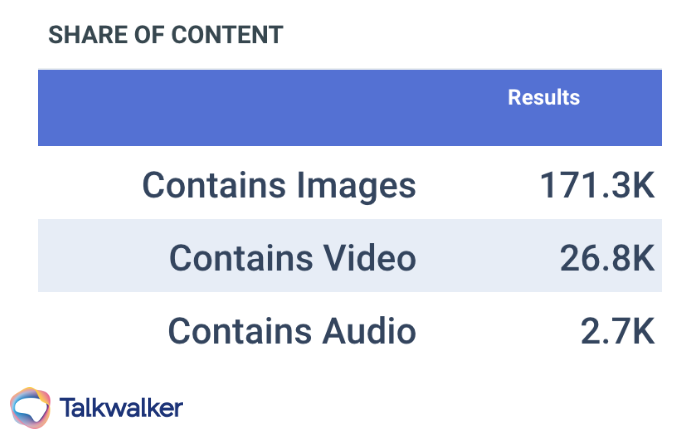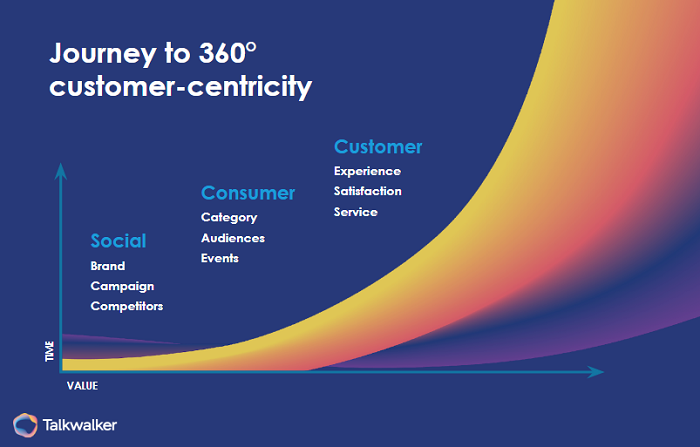What is a customer journey?
The customer journey is the idea that the person you hope will buy from you follows a path, with a series of decisions ahead of them that will or won’t lead them to purchase. They must first discover a need, and then how your products will help them solve that need.
At any point they could fall off the path, finding your solution inelegant or unwieldy, too expensive, or maybe your sales team was just annoying!
What is customer journey management?
To manage the customer journey is to reduce these pathways to lead to fewer negative outcomes from the personas you want to be your customer, and quicken negative outcomes from everyone else, to whom your products may be unnecessary.
Customer-centric brands prioritize the customer experience over everything else.
Your goal is to optimize for the quickest and best outcomes amongst your ideal audience.
These hashtags are the most associated with the customer journey, in the past six months.
What are the stages of the customer journey?
There are commonly four to seven stages of the customer journey, depending on your product or industry. Let’s use two examples to illustrate. Social media analytics tools will be one industry example, and a tourist who wants to book a flight as a more consumer-facing one.
Identification of a problem
This stage is often skipped or assumed logically but it’s worth spelling it out: your customer has to understand, first and foremost, that they have a problem that needs fixing.
SaaS company: Your ideal customer won’t know to look for a product like yours if they don’t know the importance of social media, or if their own social presence is a disaster.
Airline: Joe from Wichita dreams of going to Hawaii one day. It feels like a pipedream.
Awareness/discovery
In this stage your brand or service makes itself known to be capable of solving this problem or ones like it. This is mostly done through marketing and advertising, but it can also come from PR, word-of-mouth, or coincidence. Sometimes it pays to be in the right place at the right time.
SaaS company: Blogs, downloadables, SEO, it’s all in play for SaaS companies creating content about their niche. Make noise where your potential customers spend time.
Airline: Announcing a new direct route that’s convenient for anyone looking to fulfill their Hawaii dream vacation. Joe reads about it in the paper, or his friends share an article with him on social media about the route.
Consideration
You made it this far, your brand’s foot’s in the door! Congrats. Now is the time to convince and bring the customer home with useful information about your products. Accept and acknowledge that the competition is ever-present in this stage, and be forthright about it.
SaaS company: Statistics on the breadth of your offering, the increased utility compared to the competition, the ease of use... these are some of the features you can highlight here that might seal the deal.
Airline: Joe now knows you fly direct to his dream destination, but he’s worried about price, checking a bag, and where to stay on arrival. A sale to celebrate the new route, bundling checked bags into the seat price might be just what he needs to buy his tickets. Or do him one better - bundle the full trip, hotel and car rental into one vacation package.
Decision
“Some will win, and some will lose” …. Journey knows about the customer journey.
So the customer picks the best solution to their problem. Maybe it’s the cheapest, maybe it’s the fastest.
If you’ve managed their customer journey well, the customer will feel confident in their decision for the reasons you chose to highlight to them.
SaaS company: As the ink on the contract dries, now’s the time to wow your new customer with a warm welcome and sharing how easy it is to get started. You’re the solution they were looking for, and now that they agree with you it’s time to get solving their problems.
Airline: Joe saw the flight sale, saw the vacation package and decided it was the right price at the right time. After confirming the details it’s time to welcome him aboard. Share how excited your airline is to fly with him, and anything else he may need to know for his trip. Fun activities, cool places to eat at the destination - the goal here is to build excitement, not sell an affiliate product.
Retention
You worked so hard to win your customer, it’d be a shame if they wandered off to the competition. Retention efforts are an important part of business stability, and stability is what leads to growth. Deliver content that reminds your customers just how truly indispensable your product can be.
SaaS company: Year-in-review summaries of use cases and time spent using your product can help prove your case.
Airline: Hopefully Joe’s trip went smoothly. He’s satisfied with the service he received, and the price he paid. While another Hawaii trip isn't on the cards right now, the airline needs to work to show off their other offerings Joe may fly in the future.
Advocate/ambassador
If all goes well you’ll have turned your skeptics into a customer and advocate; an ambassador for your brand.
People like helping people, and if your customer feels satisfied with your products or services, they will feel happy to help out their network with the knowledge that they are recommending a solution that worked well for them. It’s a chance for them to burnish their own reputation as an expert.
SaaS company: Referrals can be a powerful growth channel when fostered correctly. Price and scale of your product will dictate the formality of your referral program.
Airline: At this point, not only has Joe joined the loyalty program, he’s signed up his whole family, and is telling his friends about how great the trip to Hawaii was. Joe recommended the airline to his network because the customer experience, from his front door right up to the moment his toes touched the sand on the beach, was so superior.
Mentions of the customer experience or customer journey from the US for the last six months overwhelmingly (85%) contain images to accompany them.
What is customer journey analytics?
This map of the stages of the customer journey isn’t of much use if you can’t quantify it. You may be wondering how to analyze the customer journey?
At each stage of the customer journey establish specific benchmarks or KPIs to use to chart your progress. What is the conversion rate for your brand at each stage?
Even small improvements in percentage converting from one stage to another can have an outsized impact on revenue when the process happens at scale.
You can help those conversions by using tools like heat mappers to see where on your website your traffic drops off. You can use survey data for existing leads to see what’s giving them pause. There’s a variety of metrics you could measure like cost-per-click, engagement, or reach for each stage of the journey.
Focus on what matters to you, to your brand, and prioritize it.
Remember, part of your role in managing the customer journey is to help those who are unlikely to purchase your product reach that conclusion quickly.
One platform to track every customer touch point
What makes a good customer journey map?
A good customer journey map makes two things abundantly clear:
One - each stage of the customer journey. This is a conceptual place of being. A customer will never say to you “I’m in the discovery phase of my customer journey” what they’ll say is “I’m considering all my options”.
A good customer journey map makes clear each stage of the journey.
With these vagaries in mind can you still loosely identify where in the customer journey your prospects are now?
Do you, reasonably, have a good idea of how to move them forward to the next stage of the customer journey?
Two - why it matters, to your organization or brand. A good customer journey map should make the people who see it comprehend immediately.
Because those people understand what the map is trying to convey, the recommended best practices for prospects in each stage of the customer journey should be logical, no nonsense actions.
If your team presents a solution with a prospect that’s in the decision-making stage of the customer journey, and it’s a solution to a non-existent problem or a problem that’s not a priority right now, that’s an example of a customer journey map that didn’t make clear enough its own goals, or command respect enough from the readers of the map to follow the established best practices and protocols.
A good customer journey map lays out what to do next, and the guidance is followed.
Journey to 360° customer-centricity.
A positive customer experience drives revenue, increases retention, and reduces costs.
Next steps: mapping the customer touch points
The above approaches this from the customer’s perspective of the interaction. Their purchasing perspective more specifically.
Your next task is to map out the touch points your brand has with your customers. For every action your customer took above, there is a brand action that caused it, or a brand reaction to it.
Map out these touch points to understand how and when your customers are moving through their customer journey.
Lastly, you may be wondering: where can I do all this customer journey mapping? The answer is simple. In a spreadsheet. Rows for each stage of your customers’ journey. A column for each brand reaction in the touchpoints.
Soon you’ll start to see the delicate balance between the customer and their problem. And all the ways your brand can intervene to create a solution to that problem.







